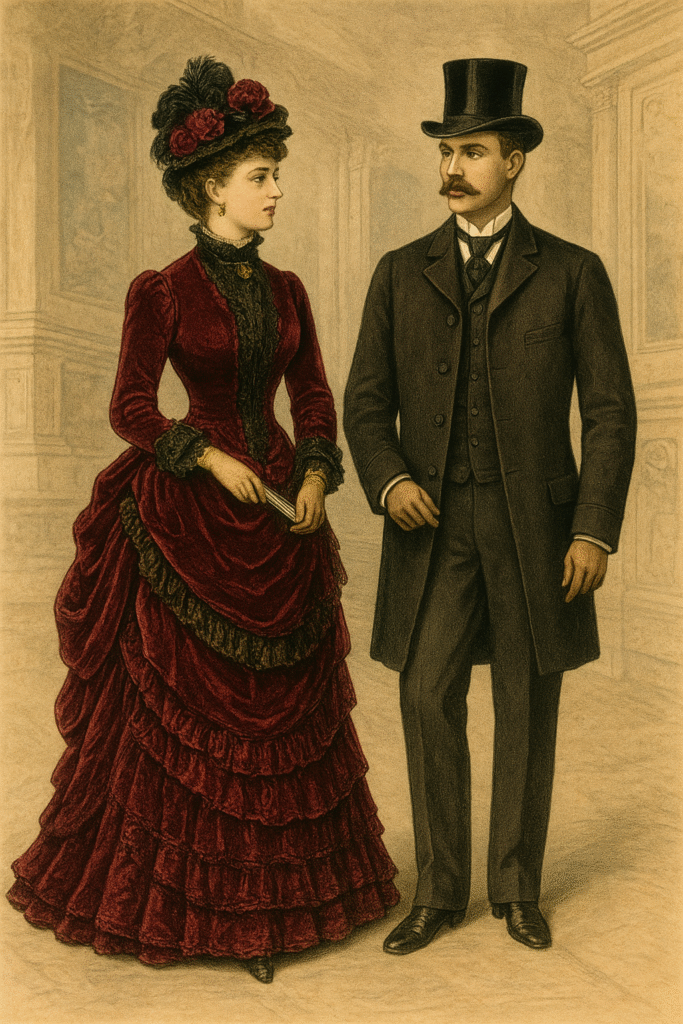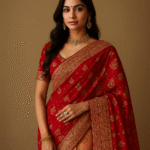The Gilded Age fashion era (roughly 1870s–1900) was one of the most fascinating periods in American history. It was a time when rapid industrial growth, immense wealth, and social divisions shaped not only the economy but also the way people dressed. Clothing in the Gilded Age reflected status, gender roles, and the cultural aspirations of a rising nation. From the opulence of the upper-class Gilded Age fashion to the practical attire of the working class, fashion became a mirror of society.
What Is the Gilded Age Fashion?
When asking “what is the Gilded Age fashion” or “what’s the Gilded Age fashion’s,” it refers to the clothing styles worn during America’s Gilded Age, a period between the Civil War and the turn of the 20th century. Fashion was characterized by luxury, elaborate design, and European influence, especially among the elite. While the wealthy flaunted their fortunes through extravagant clothing, the middle and lower classes adapted more modest versions of these trends.
Upper-Class Gilded Age Fashion
The upper-class Gilded Age fashion was all about showcasing wealth. The American elite, especially in New York Gilded Age fashion circles, spent fortunes on clothing from Paris. Wealthy women wore gowns made from silk, velvet, and satin, adorned with lace and jewels. Men of the upper class often dressed in tailored suits, top hats, and waistcoats, creating an air of sophistication.
The American upper-class Gilded Age fashion became a symbol of social status, with families like the Vanderbilts’ Gilded Age fashion choices setting the tone for high society. Their extravagant wardrobes were often displayed at balls and social gatherings, where dressing elegantly was as important as owning a mansion on Fifth Avenue.
Gilded Age Fashion’s Women
When we explore Gilded Age fashion for women, we see dramatic silhouettes defined by corsets, bustles, and layers of fabric. Dresses featured high necklines, long sleeves, and trained skirts during the day, while evening gowns showcased décolletage and were often more glamorous.
The Gilded Age fashion’s women wore reflected not only beauty but also the rigid social expectations of the time. Wealthy women rarely dressed themselves; instead, they had maids to lace corsets and arrange gowns. Fashion symbolized both privilege and restriction.
Gilded Age Fashion’s Men
Men’s Gilded Age fashion’s was equally important in defining social standing. Suits became the standard for upper and middle-class men. A typical outfit included a frock coat or sack suit, waistcoat, crisp shirt, bow tie or cravat, and polished shoes.
The Gilded Age fashion’s men wore was influenced by British tailoring. For formal events, they donned white tie or black tie attire, complete with gloves and silk hats. Meanwhile, working-class men opted for simpler, durable clothing such as wool trousers, shirts, suspenders, and caps.
Gilded Age Fashion Lower Class
The Gilded Age fashion’s lower class was far removed from the opulence of high society. Factory workers, immigrants, and rural families dressed in practical and inexpensive materials like cotton and wool. Women wore plain dresses without elaborate trims, while men wore work shirts, trousers, and boots designed for durability rather than style.
This divide highlights how the American Gilded Age fashion’s not only expressed wealth but also reinforced class differences.
Gilded Age Fashion’s Timeline
The Gilded Age fashion’s timeline can be broken into stages:
- 1870s: Bustle skirts and elaborate trims dominated women’s fashion, while men wore frock coats.
- 1880s: Women’s dresses featured even larger bustles and tight corsets. Men favored sack suits for daily wear.
- 1890s: Skirts became slimmer at the hips with puffed sleeves. Men adopted lounge suits, a precursor to modern business suits.
- 1900: Fashion transitioned toward the Edwardian era, with softer silhouettes and more practical clothing.
Fashion in New York: High Society’s Influence
New York Gilded Age fashion’s stood at the heart of America’s elite style. Fifth Avenue mansions hosted lavish balls where fashion was as much a competition as social status. The Vanderbilt family, in particular, became synonymous with extravagance, importing gowns from Paris and setting trends that rippled across the nation.
Vanderbilt Gilded Age Fashion’s
The Vanderbilt Gilded Age fashion legacy is legendary. Alva Vanderbilt’s 1883 masquerade ball remains one of the most famous fashion events of the era. Guests appeared in elaborate costumes, jewels, and imported fabrics, symbolizing the heights of luxury. Their clothing choices represented not just wealth but a cultural ambition to rival European aristocracy.
The American Gilded Age Fashion Legacy
Looking back at the Gilded Age fashion’s history, it becomes clear that clothing was more than just fabric—it was a social language. The American Gilded Age fashion’s for men and women showcased wealth, reinforced class divisions, and highlighted gender roles. Today, the styles continue to inspire period dramas, exhibitions, and even modern designers.
Gilded Age Fashion’s Men and Women: A Contrast
When comparing Gilded Age fashion’s men and women, the difference is striking. Women’s clothing emphasized decoration, curves, and opulence, while men’s fashion leaned toward formality, structure, and subtle displays of wealth. Together, they represented the ideals of prosperity, respectability, and hierarchy in society.
Read More: https://acubi.us/kalki-fashion/
FAQs
1. What is Gilded Age fashion’s?
Gilded Age fashion’s refers to the clothing styles in America between the 1870s and 1900, marked by luxury, elaborate designs, and strong European influence.
2. How did upper-class Gilded Age fashion’s differ from the lower class?
The upper class wore silk, velvet, lace, and Parisian gowns, while the lower class wore simple, durable clothes made from cotton and wool.
3. What did men wear in the Gilded Age?
Men typically wore tailored suits, waistcoats, bow ties, and top hats, while working-class men wore practical trousers, shirts, and caps.
4. What did women wear in the Gilded Age?
Women’s fashion included corsets, bustles, trained skirts, and gowns made from rich fabrics for the wealthy, with simpler cotton dresses for working women.
5. Why is Vanderbilt fashion important in the Gilded Age?
The Vanderbilt family set high-society trends, hosting extravagant balls and importing luxurious gowns, symbolizing wealth and status in New York.
Conclusion
The story of Gilded Age fashion is inseparable from the social and economic transformations of the time. Whether it was the lavish gowns of high-society women, the polished suits of elite men, or the practical attire of the working class, clothing defined identity. From upper-class Gilded Age fashion’s to Gilded Age fashion lower class, from the Vanderbilt Gilded Age fashion statements to the everyday American Gilded Age fashion, style became the ultimate expression of America’s ambitions and inequalities.
Even today, the elegance of Gilded Age fashion’s men and women continues to fascinate historians, designers, and enthusiasts, offering a glimpse into a world where clothing was both art and power.



